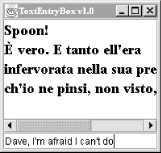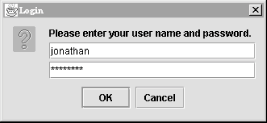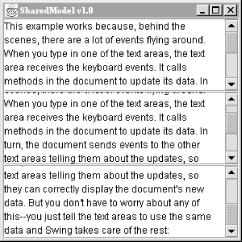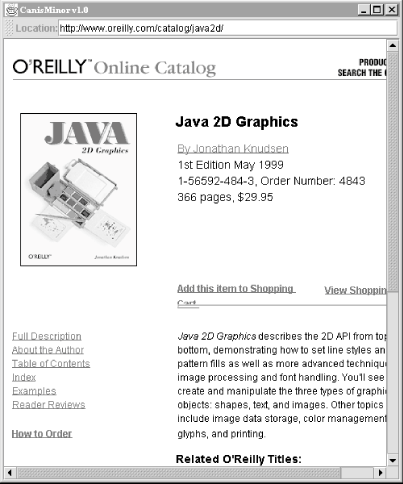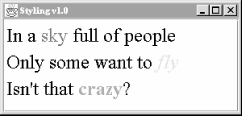In the previous chapter, we described most of the components that Swing offers for building user interfaces. In this chapter, you’ll find out about the rest. These include Swing’s text components, trees, and tables. These types of components have considerable depth, but are quite easy to use if you accept their default options. We’ll show you the easy way to use these components, and start to describe the more advanced features of each. The chapter ends with a brief description of how to implement your own components in Swing.
Swing gives us sophisticated text components, from plain text entry boxes to HTML interpreters. For full coverage of Swing’s text capabilities, see Java Swing, by Robert Eckstein, Marc Loy, and Dave Wood (O’Reilly & Associates). In that encyclopedic book, six meaty chapters are devoted to text. It’s a huge subject; we’ll just scratch the surface here.
Let’s begin by examining the simpler text components:
JTextArea
is a multiline text editor;
JTextField is a simple, single-line text editor.
Both JTextField and JTextArea
derive from the
JTextComponent
class, which provides the functionality
they have in common. This includes methods for setting and retrieving
the displayed text, specifying whether the text is
“editable” or read-only, manipulating the cursor position
within the text, and manipulating text selections.
Observing changes in text components requires an understanding of how
the components implement the
Model-View-Controller (MVC) architecture.
You may recall from the last chapter that Swing components implement
a true MVC architecture. It’s in the text components that you
first get an inkling of a clear separation between the M and VC parts
of the MVC architecture. The model for text components is an object
called a Document
. When you add or remove text from a
JTextField or a JTextArea, the
corresponding Document is changed. It’s the
document itself, not the visual components, that generates text
events when something changes. To receive notification of
JTextArea changes, therefore, you register with
the underlying Document, not with the
JTextArea component itself:
JTextArea textArea = new JTextArea( ); Document d = textArea.getDocument( ); d.addDocumentListener(someListener);
As you’ll see in an upcoming example, you can easily have more
than one visual text component use the same underlying data model, or
Document.
In addition, JTextField components generate an
ActionEvent whenever the user presses the Return
key within the field. To get these events, implement the
ActionListener interface, and call
addActionListener( ) to register.
The next sections contain a couple of simple applications that show you how to work with text areas and fields.
Our first example, TextEntryBox
, creates a JTextArea
and ties it to a JTextField, as you can see in
Figure 15.1. When the user hits Return in the
JTextField, we receive an
ActionEvent and add the line to the
JTextArea’s display. Try it out. You may
have to click your mouse in the JTextField to give
it focus before typing in it. If you fill up the display with lines,
you can test drive the scrollbar:
//file: TextEntryBox.java
import java.awt.*;
import java.awt.event.*;
import javax.swing.*;
public class TextEntryBox extends JFrame {
public TextEntryBox( ) {
super("TextEntryBox v1.0");
setSize(200, 300);
setLocation(200, 200);
final JTextArea area = new JTextArea( );
area.setFont(new Font("Serif", Font.BOLD, 18));
area.setText("Howdy!\n");
final JTextField field = new JTextField( );
Container content = getContentPane( );
content.add(new JScrollPane(area), BorderLayout.CENTER);
content.add(field, BorderLayout.SOUTH);
setVisible(true);
field.requestFocus( );
field.addActionListener(new ActionListener( ) {
public void actionPerformed(ActionEvent ae) {
area.append(field.getText( ) + '\n');
field.setText("");
}
});
}
public static void main(String[] args) {
JFrame f = new TextEntryBox( );
f.addWindowListener(new WindowAdapter( ) {
public void windowClosing(WindowEvent we) { System.exit(0); }
});
f.setVisible(true);
}
}
TextEntryBox is
exceedingly simple; we’ve done a few things to make it more
interesting. We give the text area a bigger font using
Component
’s setFont( )
method; fonts are discussed in Chapter 17. Finally,
we want to be notified whenever the user presses Return in the text
field, so we register an anonymous inner class as a listener for
action events.
Pressing Return in the JTextField generates an
action event, and that’s where the fun begins. We handle the
event in the actionPerformed( ) method of our
inner ActionListener
implementation.
Then we use the getText( ) and setText( ) methods to manipulate
the text the user has typed. These methods can be used for both
JTextField and JTextArea,
because these components are derived from the
JTextComponent class, and therefore have some
common functionality.
The event handler, actionPerformed( ), calls
field.getText( ) to read the text that the user
typed into our JTextField. It then adds this text
to the JTextArea by calling area.append( ). Finally, we clear the text field by calling the method
field.setText(""), preparing it for more input.
Remember, the text components really are distinct from the text data
model, the Document. When you call
setText( ), getText( ), or
append( ), these methods are shorthand for
operations on an underlying Document.
By default, JTextField and
JTextArea are editable; you can type and edit in
both text components. They can be changed to output-only areas by
calling setEditable(false). Both text components
also support selections. A selection is a range
of text that is highlighted for copying and pasting in your windowing
system. You select text by dragging the mouse over it; you can then
copy and paste it into other text windows. The current text selection
is returned by getSelected-Text( )
.
Notice how JTextArea fits neatly inside a
JScrollPane
. The scroll pane gives us the expected
scrollbars and scrolling behavior if the text in the
JTextArea becomes too large for the available
space.
Swing includes a class just for typing
passwords, called
JPasswordField. A
JPasswordField behaves just like a
JTextField (it’s a subclass), except every
character that’s typed is echoed as a single
character, typically an asterisk.
Figure 15.2 shows the option dialog example
that was presented in Chapter 14. The example
includes a JTextField and a
JPasswordField.
The creation and use of JPasswordField is
basically the same as for JTextField. If you find
asterisks distasteful, you can tell the
JPasswordField to use a different character using
the setEchoChar( )
method.
Normally, you would use getText( ) to retrieve the
text typed into the JPasswordField. This method,
however, is deprecated; you should use getPassword( )
instead. The
getPassword( ) method returns a character array
rather than a String object. This is done because
character arrays are less vulnerable than Strings
to discovery by memory-snooping password sniffer programs. If
you’re not that concerned, you can simply create a new
String from the character array. Note that methods
in the Java cryptographic classes accept passwords as character
arrays, not strings, so it makes a lot of sense to pass the results
of a getPassword( ) call directly to methods in
the cryptographic classes, without ever creating a
String.
Our next example shows how easy it is to make two or more
text components share the same
Document; Figure 15.3 shows
what the application looks like. Anything the user types into any
text area is reflected in all of them. All we had to do is make all
the text areas use the same data model, like this:
JTextArea areaFiftyOne = new JTextArea( ); JTextArea areaFiftyTwo = new JTextArea( ); areaFiftyTwo.setDocument(areaFiftyOne.getDocument( )); JTextArea areaFiftyThree = new JTextArea( ); areaFiftyThree.setDocument(areaFiftyOne.getDocument( ));
We could just as easily make seven text areas sharing the same document, or seventy. While this example may not look very useful, keep in mind that you can scroll different text areas to different places in the same document. That’s one of the beauties of putting multiple views on the same data—you get to examine different parts of it. Another useful technique is viewing the same data in different ways. You could, for example, view some tabular numerical data as both a spreadsheet and a pie chart. The MVC architecture that Swing uses means that it’s possible to do this in an intelligent way, so that if numbers in a spreadsheet are updated, a pie chart that uses the same data will automatically be updated also.
This example works because behind the scenes, there are a lot of events flying around. When you type in one of the text areas, the text area receives the keyboard events. It calls methods in the document to update its data. In turn, the document sends events to the other text areas telling them about the updates, so they can correctly display the document’s new data. But you don’t have to worry about any of this—you just tell the text areas to use the same data and Swing takes care of the rest:
//file: SharedModel.java
import java.awt.*;
import java.awt.event.*;
import javax.swing.*;
public class SharedModel extends JFrame {
public SharedModel( ) {
super("SharedModel v1.0");
setSize(300, 300);
setLocation(200, 200);
JTextArea areaFiftyOne = new JTextArea( );
JTextArea areaFiftyTwo = new JTextArea( );
areaFiftyTwo.setDocument(areaFiftyOne.getDocument( ));
JTextArea areaFiftyThree = new JTextArea( );
areaFiftyThree.setDocument(areaFiftyOne.getDocument( ));
Container content = getContentPane( );
content.setLayout(new GridLayout(3, 1));
content.add(new JScrollPane(areaFiftyOne));
content.add(new JScrollPane(areaFiftyTwo));
content.add(new JScrollPane(areaFiftyThree));
setVisible(true);
}
public static void main(String[] args) {
JFrame f = new SharedModel( );
f.addWindowListener(new WindowAdapter( ) {
public void windowClosing(WindowEvent we) { System.exit(0); }
});
f.setVisible(true);
}
}Setting up the display is simple. We use a
GridLayout (discussed in the next chapter) and add
three text areas to the layout. Then all we have to do is tell the
text areas to use the same Document.
Most user interfaces will use only two subclasses of
JTextComponent. These are the simple
JTextField and JTextArea
classes that we just covered. That’s just the tip of the
iceberg, however. Swing offers sophisticated text capabilities
through two other subclasses of
JTextComponent:
JEditorPane and JTextPane.
The first of these, JEditorPane, can display
HTML and RTF documents. It also
fires one more type of event, a
HyperlinkEvent
. Subtypes of this event are fired off
when the mouse enters, exits, or clicks on a hyperlink. Combined with
JEditorPane’s HTML display capabilities,
it’s very easy to build a simple
browser. Here’s one in fewer than 100
lines:
//file: CanisMinor.java
import java.awt.*;
import java.awt.event.*;
import java.net.*;
import javax.swing.*;
import javax.swing.event.*;
public class CanisMinor extends JFrame {
protected JEditorPane mEditorPane;
protected JTextField mURLField;
public CanisMinor(String urlString) {
super("CanisMinor v1.0");
createUI(urlString);
setVisible(true);
}
protected void createUI(String urlString) {
setSize(500, 600);
center( );
Container content = getContentPane( );
content.setLayout(new BorderLayout( ));
// add the URL control
JToolBar urlToolBar = new JToolBar( );
mURLField = new JTextField(urlString, 40);
urlToolBar.add(new JLabel("Location:"));
urlToolBar.add(mURLField);
content.add(urlToolBar, BorderLayout.NORTH);
// add the editor pane
mEditorPane = new JEditorPane( );
mEditorPane.setEditable(false);
content.add(new JScrollPane(mEditorPane), BorderLayout.CENTER);
// open the initial URL
openURL(urlString);
// go to a new location when enter is pressed in the URL field
mURLField.addActionListener(new ActionListener( ) {
public void actionPerformed(ActionEvent ae) {
openURL(ae.getActionCommand( ));
}
});
// add the plumbing to make links work
mEditorPane.addHyperlinkListener(new LinkActivator( ));
// exit the application when the window is closed
addWindowListener(new WindowAdapter( ) {
public void windowClosing(WindowEvent e) { System.exit(0); }
});
}
protected void center( ) {
Dimension screen = Toolkit.getDefaultToolkit().getScreenSize( );
Dimension us = getSize( );
int x = (screen.width - us.width) / 2;
int y = (screen.height - us.height) / 2;
setLocation(x, y);
}
protected void openURL(String urlString) {
try {
URL url = new URL(urlString);
mEditorPane.setPage(url);
mURLField.setText(url.toExternalForm( ));
}
catch (Exception e) {
System.out.println("Couldn't open " + urlString + ":" + e);
}
}
class LinkActivator implements HyperlinkListener {
public void hyperlinkUpdate(HyperlinkEvent he) {
HyperlinkEvent.EventType type = he.getEventType( );
if (type == HyperlinkEvent.EventType.ENTERED)
mEditorPane.setCursor(
Cursor.getPredefinedCursor(Cursor.HAND_CURSOR));
else if (type == HyperlinkEvent.EventType.EXITED)
mEditorPane.setCursor(Cursor.getDefaultCursor( ));
else if (type == HyperlinkEvent.EventType.ACTIVATED)
openURL(he.getURL().toExternalForm( ));
}
}
public static void main(String[] args) {
String urlString = "http://www.oreilly.com/catalog/java2d/";
if (args.length > 0)
urlString = args[0];
new CanisMinor(urlString);
}
}This browser is shown in Figure 15.4.
JEditorPane
is the center of this little application.
Passing a URL to setPage( ) causes the
JEditorPane to load a new page, either from a
local file or from somewhere across the Internet. To go to a new
page, enter it in the text field at the top of the window and press
Return. This fires an ActionEvent which sets the
new page location of the JEditorPane. It can
display RTF files, too. (RTF is the text or non-binary storage format
for Microsoft Word documents.)
Responding to
hyperlinks correctly is simply a matter of
responding to the HyperlinkEvents thrown by the
JEditorPane. This behavior is encapsulated in the
LinkActivator inner class. If the mouse enters a
hyperlink area, the cursor is changed to a hand. It’s changed
back when the mouse exits a hyperlink. If the user
“activates” the hyperlink by clicking on it, we set the
location of the JEditorPane to the location given
under the hyperlink. Surf away!
Behind the scenes, something called an
EditorKit
handles displaying documents for the
JEditorPane. Different kinds of
EditorKits are used to display different kinds of
documents. For HTML, the HTMLEditorKit class (in
the javax.swing.text.html package) handles the
display. Currently, this class supports HTML 3.2. Subsequent releases
of the SDK will contain enhancements to the capabilities of
HTMLEditorKit; eventually, it will support HTML
4.0.
There’s another component here that we haven’t covered
before—the
JToolBar
. This nifty container houses our URL text
field. Initially, the JToolBar starts out at the
top of the window. But you can pick it up by clicking on the little
dotted box near its left edge, then drag it around to different parts
of the window. You can place this toolbar at the top, left, right, or
bottom of the window, or you can drag it outside the window entirely.
It will then inhabit a window of its own. All this behavior comes for
free from the JToolBar class. All we had to do was
create a JToolBar and add some components to it.
The JToolBar is just a container, so we add it to
the content pane of our window to give it an initial location.
Swing offers one last subclass of
JTextComponent that can do just about anything you
want: JTextPane. The basic text components,
JTextField and JTextArea, are
limited to a single font in a single style. But
JTextPane, a subclass of
JEditorPane, can display multiple fonts and
multiple styles in the same component. It also includes support for a
cursor (caret), highlighting, image embedding, and other advanced
features.
We’ll just take a peek at JTextPane here by
creating a text pane with some styled text. Remember, the text itself
is stored in an underlying data model, the
Document
. To create styled text, we simply
associate a set of text
attributes with different parts of the document’s
text. Swing includes classes and methods for manipulating sets of
attributes, like specifying a bold font or a different color for the
text. Attributes themselves are contained in a class called
SimpleAttributeSet
; these attribute sets are manipulated
with static methods in the StyleConstants class.
For example, to create a set of
attributes that specifies the color red, you could do this:
SimpleAttributeSet redstyle = new SimpleAttributeSet( ); StyleConstants.setForeground(redstyle, Color.red);
To add some red text to a document, you would just pass the text and
the attributes to the document’s insertString( )
method, like this:
document.insertString(6, "Some red text", redstyle);
The first argument to insertString( ) is an offset
into the text. An exception is thrown if you pass in an offset
that’s greater than the current length of the document. If you
pass null for the attribute set, the text is added
in the JTextPane’s default font and style.
Our simple example creates several attribute sets and uses them to
add plain and styled text to a
JTextPane
, as shown in Figure 15.5.
//file: Styling.java
import java.awt.*;
import java.awt.event.*;
import javax.swing.*;
import javax.swing.text.*;
public class Styling extends JFrame {
private JTextPane textPane;
public Styling( ) {
super("Styling v1.0");
setSize(300, 200);
setLocation(200, 200);
textPane = new JTextPane( );
textPane.setFont(new Font("Serif", Font.PLAIN, 24));
// create some handy attribute sets
SimpleAttributeSet red = new SimpleAttributeSet( );
StyleConstants.setForeground(red, Color.red);
StyleConstants.setBold(red, true);
SimpleAttributeSet blue = new SimpleAttributeSet( );
StyleConstants.setForeground(blue, Color.blue);
SimpleAttributeSet italic = new SimpleAttributeSet( );
StyleConstants.setItalic(italic, true);
StyleConstants.setForeground(italic, Color.orange);
// add the text
append("In a ", null);
append("sky", blue);
append(" full of people\nOnly some want to ", null);
append("fly", italic);
append("\nIsn't that ", null);
append("crazy", red);
append("?", null);
Container content = getContentPane( );
content.add(new JScrollPane(textPane), BorderLayout.CENTER);
setVisible(true);
}
protected void append(String s, AttributeSet attributes) {
Document d = textPane.getDocument( );
try { d.insertString(d.getLength( ), s, attributes); }
catch (BadLocationException ble) {}
}
public static void main(String[] args) {
JFrame f = new Styling( );
f.addWindowListener(new WindowAdapter( ) {
public void windowClosing(WindowEvent we) { System.exit(0); }
});
f.setVisible(true);
}
}This example creates a JTextPane, which is saved
away in a member variable. Three different attribute sets are
created, using combinations of text styles and foreground colors.
Then, using a helper method called append( )
, text
is added to the JTextPane.
The append( ) method tacks a text
String on the end of the
JTextPane’s document, using the supplied
attributes. Remember that if the attributes are
null, the text is displayed with the
JTextPane’s default font and style.
You can go ahead and add your own text, if you wish. If you place the
caret inside one of the differently styled words and type, the new
text comes out in the appropriate style. Pretty cool, eh?
You’ll also notice that JTextPane gives us
word-wrapping behavior for free. And since we’ve wrapped the
JTextPane in a JScrollPane, we
get scrolling for free, too. Swing allows you to do some really cool
stuff without breaking a sweat. Just wait—there’s plenty
more to come.
This simple example should give you some idea of what
JTextPane can do. It’s reasonably easy to
build a simple word processor with JTextPane, and
complex commercial-grade word processors are definitely possible.
If JTextPane still isn’t good enough for
you, or you need some finer control over character, word, and
paragraph layout, you can actually draw text, carets, and highlight
shapes yourself. A class in the 2D API called
TextLayout
simplifies much of this work, but
it’s outside the scope of this book. For coverage of
TextLayout and other advanced text
drawing topics,
see Java 2D Graphics by Jonathan Knudsen
(O’Reilly & Associates).
Get Learning Java now with the O’Reilly learning platform.
O’Reilly members experience books, live events, courses curated by job role, and more from O’Reilly and nearly 200 top publishers.
